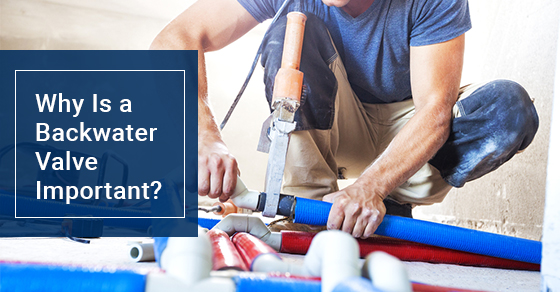Why Is a Backwater Valve Important?

Keeping the water flowing in your home or business is important. However, there are times when property owners have to deal with water issues like flooding or sewage backup. No one likes to deal with the damage, the mess, or the cost of water problems in your home or building. There are a variety of ways to protect your property against water damage. A backwater valve is one of those small solutions to big problems.
What is a backwater valve?
A backwater valve can be a lifesaver when you are facing a sewage problem. It is also called a backflow valve and has been designed to stop your sewer from overflowing and flooding your home or building. There are different types of backwater valves that provide different levels of protection. However, the most common has a flap on the back of the valve that allows water to flow out from your property. If the water is starting to back up in the pipes and trying to flow into your home or building, the valve will sense it and the flap will close, stopping a potential flooding disaster. Yet, it is important to know that it will also cease the flow of water from your property until the problem has been fixed. So, while it is helpful in preventing unwanted water from getting into your home or office, it can also be a hassle, as you cannot send water down your pipes until the threat of flooding has ended. Sometimes, this means waiting on your municipality to address the issue.
Types of Backwater Valves
There are three main types of backwater valves that you can have installed in your home or building. These include:
-
Check Valve
The most economical choice is a check valve. It has a flap or ball that will close and block the water flow to your property if there is a backup. The drawback of these valves is that they are the ones which require the most maintenance.
-
Gate Valve
While they are more dependable, gate valves require someone to close and open sewer lines if there is a blockage. They also cost more than check valves.
-
Combination Valve
This type is equipped with a chamber and a gate that is full of air. When a backup is sensed, the gate closes. This style is the most expensive, but also comes with an alarm to let you know if the sewer line has been blocked or not.
Unfortunately, not all backwater valves are built well. There are some poorer quality valves that can cause more trouble than they prevent. The Insurance Bureau of Canada advises against the plug type, which can cause pressure to build up as it holds the sewer water out. This can lead to structural damage to your property and high repair costs, something that no homeowner or property manager wants to have to handle.
Benefits of a Backwater Valve
There are a number of issues that can lead to sewage backup. A clogged pipe, tree roots, and more can mean the flow to your bathroom or kitchen stops. The primary benefit of having a backwater valve put into your home or building is that it can help prevent any potential flooding. Having the peace of mind that comes with knowing your property is secure can be worth it to have one installed.
Depending on where in Canada your property is located, your municipality may offer a subsidy to help cover the costs of installing a backwater valve. It is also recommended that you check with your insurance company, as some offer incentives to homeowners and commercial property managers that opt to have a backwater valve installed.
Essentially, a backwater valve can save you the hassle and expense that comes with flooding of your home or building. When flooding happens, it can not only create a health hazard for those in the property, but it can also damage your home or building such as your floors, walls, and furniture. Moreover, any items that you have stored in your basement might be lost for good; including valuables, mementos, or important files and documents. A backwater valve is your best defence against this scenario.
It is important to note that backwater valves are not a DIY project. The complexity of installing a backwater valve is best left for the professionals.
Maintain Your Backwater Valve
There are some steps you can take to ensure that your backwater valve is in good working condition.
- Inspect your valve at least once a year, and more if there has been an incident such as a heavy storm. Check each part of the valve to make sure it is clean and doesn’t need to be replaced.
- Clean away any debris that has collected by flushing the valve with a hose or bucket of water.
- Be careful about what you flush. Only toilet paper and human waste should be flushed. Anything else can cause problems in your pipes and with your backwater valve.
- It is important to have your backwater valve checked by a professional at least once a year.
As well, backwater valves are designed to last several years if they are properly maintained. So, if your valve is more than a few years old, it is a good idea to have a professional plumber examine it and replace it if needed.
Conclusion
Securing your home or building from flooding can be a serious issue for property owners. Installing and maintaining a backwater valve can help prevent unwanted fluid from getting into your home or building. Consider it an investment that prevents expensive cleanup and repair costs that can come from flooding.
For more information about how to unclog your drain, call Brothers Plumbing at 1-800-742-0018 or contact us here.
Posted By Brothers Plumbing
0 Comment
